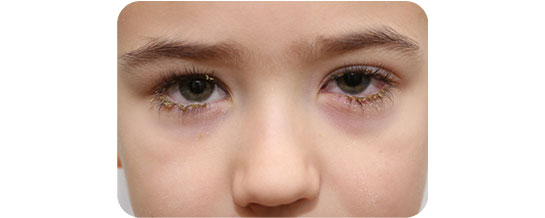Conjunctivitis

What is conjunctivitis?
Conjunctivitis is the inflammation (swelling) of the conjunctiva. The conjunctiva is the tissue that lines the inside surface of the eyelid and outer coating of the eye. This tissue helps keep the eyelid and eyeball moist. Conjunctivitis is a very common eye infection in children, often called “pink eye”
Conjunctivitis can be upsetting because it may make the eyes very red and can spread quickly, but it is fairly common and usually causes no long-term eye or vision damage
What causes conjunctivitis?
Conjunctivitis can either be caused by a bacterial /viral infection or by an allergy. Newborn babies are especially prone to conjunctivitis as a result of bacterial infection in the birth canal.
In older children, the cause is usually a virus, a bacteria or an allergy. Viral or bacterial conjunctivitis is infectious and can pass from one eye to the other and from person to person.
This might happen by sharing towels, direct contact or contaminated objects and surfaces.
What are the symptoms?
- Red, itchy eyes and sticky eyelids
- Eyes will water more than usual, and may have a discharge
- Thick yellow discharge that crusts over the eyelashes, especially after sleep (in conjunctivitis caused by bacteria)
- Blurred vision
- Increase sensitivity to light
How is conjunctivitis diagnosed?
A child with symptoms of conjunctivitis should visit the eye clinic. At the eye clinic, the nurse or doctor may take a swab (sample) of the discharge from the eye that can be tested for any bacteria or virus.
How is it treated?
The type of treatment the child will need will depend on the type of conjunctivitis they have:
Bacteria
Conjunctivitis caused by bacteria is treated with antibiotics, a type of medicine prescribed by your doctor. The antibiotic can be given as eye drops or eye ointment. Eye drops or ointment may need to be applied to the eye 3 to 4 times a day for 5 to 7 days.
Eye drops won’t be painful but might cause a small stinging sensation.
Virus
Medicine cannot treat conjunctivitis caused by a virus. This type of conjunctivitis often results from a common cold. Just as a cold must run its course, so must this form of conjunctivitis, which will last from four to seven days. You can help relieve symptoms by applying a cold compress and using artificial tears eye drops (lubricating eye drops) as recommended by your doctor.
Allergies
If the child’s conjunctivitis is caused by an allergic reaction, the doctor will probably suggest antihistamine medicine to soothe the irritation.
Symptoms can also be relieved by gently cleaning away any crusty discharge with clean cotton balls soaked in boiled cooled water (boil the water first, then leave it to cool down before use). Start in the corner of the eye, and gently wipe to the outer eye. Use a separate piece of cotton ball for each eye to prevent spreading the infection.
How to prevent conjunctivitis from spreading?
- Do not touch or rub the infected eye(s)
- Wash your child’s hands often with soap and warm water
- Wash any discharge from your child’s eyes using a fresh cotton ball or paper towel Afterwards, discard the cotton ball and wash your hands with soap and warm water
- Wash your child’s bed linens, pillowcases, and towels in hot water and detergent
- Avoid sharing your child’s common articles such as unwashed towels, cups, and glasses
- Wash your hands after applying eye drops or ointment to your child’s eye
- Do not use eye drops that were used for an infected eye in a non-infected eye
- Make sure your child does not share towels with anyone else in the family to help contain the infection
If you have any questions or concerns:
Please contact Sidra eye clinic.

